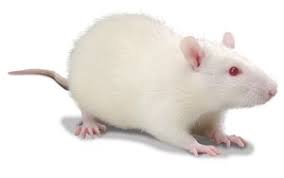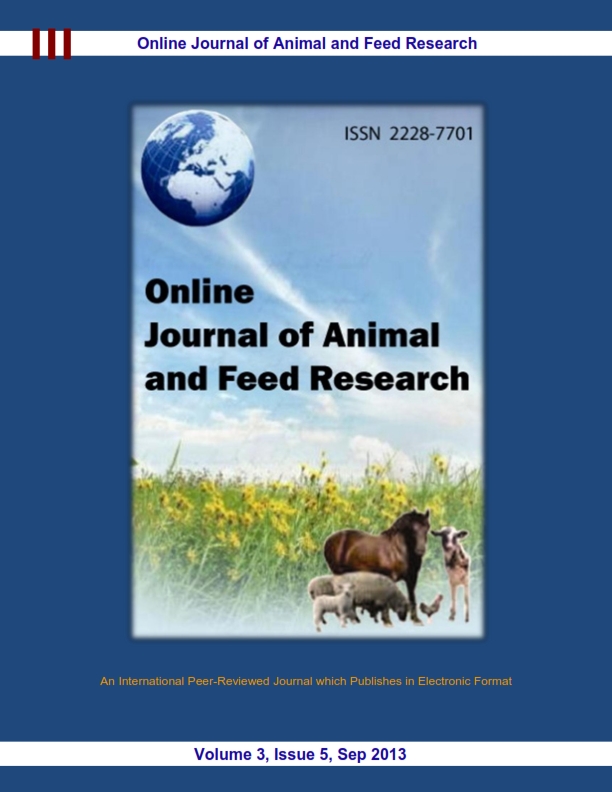|
Research Title /
Graphical Abstract
|
Article Information /
Abstract
|
Download
|
|
Forage species availability, preference and grazing behaviour of Muturu and Zebu cattle in Asaba, Delta State, Nigeria
|
Original Research, C39
pii: S222877011300039-3
Udeh I, Isikwenu JO and Obika GC.
Online J. Anim. Feed Res., 3(5): 197-201, 2013.
ABSTRACT: The objectives of this study were to identify the forage species available, species preference and to compare the grazing behaviour of Muturu and Zebu cattle under semi intensive system of management in Delta State University, Asaba Campus, Asaba Nigeria. Eleven cattle made up of one bull and ten cows each of Muturu and zebu were used for the study. There were five grazing areas. The total number of plant species, their population density and the most significant forage species preferred by the cattle were noted by the use of the quadrat method. Seventeen forage species were classified comprising twelve grasses, two legumes, two shrubs and one tree, which formed most of their food. Among the forage species identified, panicum maximum, grass specie was the most preferred and incidentally the widest spread forage in the area. Zebu significantly (P<0.05) bites more than muturu on ellusine indica, axonopus compressus, imperata cylindrica cynodon polystachus, centrosema pubescen and aspilla Africana. Muturu cattle showed significantly (P<0.05) greater preference for sida acuta and tridax procumbens than zebu. Zebu cattle spent significantly (P<0.05) more time on resting, courtship behaviour, brushing of the body and digging of soil than Muturu. Muturu cattle spent significantly (P<0.05) more time on playing and bullying than zebu. The finding in this study will be useful in the establishment of pastures and grazing management of muturu and zebu cattle in this ecological zone of the country.
Key words: Cattle, Plant Species, Population Density, Preference, Time Spent
|

-

|
|
Effect of within herd environmental factors on milk, fat and protein yields in red Dane cattle in Zimbabwe
|
Original Research, C40
pii: S222877011300040-3
Nyamushamba G. B, Halimani T. E, Imbayarwo-Chikosi V.E, Tavirimirwa B and Zishiri O.T.
Online J. Anim. Feed Res., 3(5): 202-204, 2013.
ABSTRACT: A study was carried out to establish within herd environmental factors affecting milk yield, butterfat and protein in Zimbabwean Red Dane cattle. 305-day lactation records were obtained from the Livestock Identification Trust (LIT) containing herds with cows that calved from 2004 to 2009. A General Linear Model (GLM) procedure of the Statistical Analysis System version 9.1.3 was used to determine the effect environmental factors on milk yield and composition. Age at calving fitted as covariates, the effect of calving interval and herd-year-season were analysed. Milk yield, fat and protein content obtained increased with an increase in calving interval. It is thus important to pre-adjust data for these environmental factors when carrying out genetic evaluations of production traits in dairy cattle.
Key words: Environmental Factors, Herd-Year-Season, Calving Interval, Age at Calving
|
-

-

|
|
Responses of albino rats to high rice bran diets: effects of type of rice bran and level of X-Zyme™ (An Exogenous Enzymes + Probiotics Feed Additive)


|
Original Research, C41
pii: S222877011300041-3
Okai D. B., Boateng M., Armah W. N. L. and Frimpong Y. O.
Online J. Anim. Feed Res., 3(5): 205-209, 2013.
ABSTRACT: The experiment was conducted to determine the effects of high (60%) rice bran-based diets with rice brans of different qualities (Type A-poor and Type B-good) and 2 levels of X-zymeTM (an exogenous enzymes+probiotics feed additive) on the growth performance and carcass characteristics of albino rats. Thirty albino rats were randomly allotted to five dietary treatments, T1 (maize-based, Control), and four other diets containing rice bran with differing quality (A and B) plus X-zymeTM at two levels (250 and 500mg/kg) labeled: T2 (Type A RB+250mg X-zymeTMper Kg feed), T3 (Type A RB+500mg X-zymeTM per Kg feed), T4 (Type B RB+250mg X-zymeTM per Kg feed) and T5 (Type B RB+500mg X-zymeTM per Kg feed). There were 6 rats on each treatment, housed individually in plastic cages and each rat served as a replicate. Feed and water were provided ad libitum and their growth performance monitored for 28 days after which the rats were euthanized for carcass measurements. Data collected showed significant (P<0.05) differences in weight gain, feed intake, feed efficiency and the feed cost per 100g gain with better growth performance trends for treatments T1 (Control), T4 and T5 (Type B rice bran). Also, there were significant differences in the weights of kidneys, liver, lungs, heart and the empty stomach. It was concluded that, the composition of agro industrial by-products such as rice bran may have an effect on how efficiently they are utilized by monogastric farm animals even when some nutrient releasing and growth promoting feed additives have been added.
Key words: Exogenous Enzymes, High Levels, Probiotics, Quality, Rice Bran.
|
-

-

|
|
Nutritional evaluation of processed mango (Mangifera indica - Kent) seed kernel meal as replacement for maize in the diet of growing crossbred rabbits

|
Original Research, C42
pii: S222877011300042-3
Shittu M. D., Olabanji R.O., Ojebiyi O.O., Amao O.A. and Ademola S.G.
Online J. Anim. Feed Res., 3(5): 210-215, 2013.
ABSTRACT: A study was conducted to investigate the effect of different inclusion levels of sun-dried and parboiled mango seed kernel meal in diets of growing rabbits. Thirty crossbred male rabbits of between 6-8 weeks old with average initial weight of between 630.70g-646.36g were used. Five diets were formulated to contain 0 (control) 10 and 20% sun-dried mango seed kernel meal (SMSKM) and 10 and 20% parboiled mango seed kernel meal (PMSKM) substituted for maize of the control diet. The rabbits were randomly divided in to five groups of six rabbits each with each rabbit serving as replicate in a complete randomized block design experiment. Feed and water were offered ad libitum. The response criteria shows that the average daily feed intake ranged from 63.51 to 71.57g for all the five diets. Effects of dietary treatments on weight gain and feed conversion ratio were not significant (P>0.05). The relative weights of the organs examined (liver, spleen, heart, testis, lung, kidney) were not significantly (P>0.05) different across dietary treatments. The feed cost/ kg reduced significantly (P<0.05) as the levels of inclusion of MSKM increased. It was concluded that SMSKM and PMSKM can be included up to 20% level in growing rabbit rations without adverse effect on growth performance and carcass characteristics of growing rabbits. Mango seed kernel used in this study is of no direct value for man hence its utilization as a feed ingredient will lower feed cost and encourage increased production of meat and by implication availability of more animal protein to the populace.
Key words: Mango Seed Kernel Meal, Parboiled, Crossbred Rabbits, Performance, Carcass Characteristics
|
-

-

|
|
|
|
|
|
|
|
|
|
|
|
|
|
|
|
|
|
|
|
|
|
|
|
|
|
|
|
|
iginal Research, B70
------
Online J. Anim. Feed Res., 2(4): 000-000, 2012.
ABSTRACT:
Key words: |
|
|
|
|



